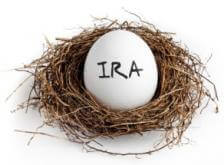10 Costly Retirement Account Mistakes (Part 1)
Money Girl covers 10 retirement account mistakes that could end up hurting your finances and how to easily avoid them.
One of the best ways to make sure you have a happy financial future is to get in the habit of setting aside money every month in a tax-advantaged retirement account. But with all the rules and regulations that come with these accounts, you may be worried that you’ll slip up and make a costly mistake.
In this 2-part series, you’ll learn 10 retirement account mistakes that could end up hurting your finances and how to easily avoid them. We’ll cover IRAs in this episode and then workplace accounts in Part 2.
Sponsor: Squarespace, the all-in-one platform that makes it fast and easy to create your own professional website, e-commerce site, or online portfolio. For a free trial and 10% off, go to Squarespace moneygirl and use offer code MoneyGirl.
Click here to subscribe to the weekly Money Girl audio podcast—it’s FREE!
What Is an Individual Retirement Arrangement (IRA)
One of the easiest ways to start putting money aside for retirement is to open up and contribute to an Individual Retirement Arrangement or IRA. These accounts allow you to set aside money with some nice tax savings.
The great thing about an IRA is that you control it, not an employer. It’s available to just about anyone who has earned income, even minors. For 2013 and 2014, you can contribute up to $5,500 or up to $6,500 if you’re age 50 or older.
Once you have money in an IRA, you can invest it, put it in a bank CD, or even keep it in a savings account. There are 2 main types of IRAs: traditional and Roth.
With a traditional IRA, you get a tax deduction for your contributions each year. In other words, the income you set aside isn’t taxed. Plus, you don’t pay tax on the earnings and growth in the account, until you withdraw money in retirement.
With a Roth IRA you don’t get a tax deduction for your contributions—they’re taxed before going into the account. However, the earnings and growth in the account are never taxed, even when you take withdrawals in retirement. Note that there are annual income limits that you can’t exceed in order to make Roth contributions.
No matter if you choose a traditional or Roth IRA, the tax benefits can turbo-charge your savings more quickly than if your money was in a taxable brokerage firm account. The more you contribute each year, the more you’ll benefit from the tax savings and make progress toward your retirement goals.
5 IRA Mistakes to Avoid
Now that you know the IRA basics, here are 5 costly mistakes you should avoid:
Mistake #1: Making an Early Withdrawal
Remember that a retirement account is designed for retirement. That means you’re not supposed to touch it until you reach the official retirement age of 59½!
If you make a withdrawal from your traditional IRA before retirement, not only will you have to pay taxes on the amount, but typically also a steep 10% early withdrawal penalty.
See also: 5 Tax Rules for Taking an Early Withdrawal from a Retirement Account
A Roth IRA allows you to withdraw contributions because they were previously taxed. But if you withdraw earnings before retirement, they will be subject to tax and a 10% penalty.
If you’re married and file a joint tax return, you and your spouse can both contribute to an IRA—even if only one of you has earned income.
Mistake #2: Assuming You Can’t Contribute
I mentioned that you must have earned income to be eligible to make an IRA contribution. But there’s an important exception to that rule that many people miss.
If you’re married and file a joint tax return, you and your spouse can both contribute to an IRA—even if only one of you has earned income. This is great news for anyone who might be a stay-at-home parent or temporarily unemployed.
The total contributions to your IRA and to your spouse’s may not exceed your joint taxable income or the annual contribution limits, whichever is less. For 2013 and 2014, that means you could both max out IRAs as long as you earn at least $11,000 ($5,500 + $5,500), or $13,000 ($6,500 + $6,500) if you’re both over age 50.
Mistake #3: Not Using Rollovers
If you leave a job where you had a workplace retirement account, such as a 401(k) or 403(b), don’t forget about your money. An easy way to consolidate one or more retirement plans is to roll them over into an IRA.
Doing a rollover involves 3 steps:
- Open the appropriate IRA.
- Initiate a rollover from your former employer’s plan custodian by submitting a distribution request, using a paper or online form.
- Choose how to allocate your money in the new IRA.
See also: What Is an IRA Rollover?
Doing a trustee-to-trustee transfer or direct rollover is best, so your money goes straight from your old plan into your new IRA and there are no tax implications. If you keep any portion of a rollover distribution longer than 60 days, you’ll owe income tax plus a hefty 10% penalty if you’re under age 59½.
Mistake #4: Thinking You Missed the Contribution Deadline
While December 31 is the deadline to contribute to some types of retirement accounts, that’s not the case with IRAs. You actually have 3½ more months, until tax filing day, to make a traditional or Roth IRA contribution for the previous year.
See also: 15 IRA Rules You Should Know
So while it’s best to make retirement contributions earlier rather than later, putting it off until after the New Year is okay—just don’t miss the April 15 deadline.
Mistake #5: Waiting to Get Started
Many times what hurts the most isn’t picking the wrong investment—it’s waiting too long to get started investing in the first place. The earlier you get into the habit of putting money aside for the future, the better.
You can avoid the natural tendency to procrastinate and make excuses by setting up monthly automatic transfers from your bank account into your IRA. After a while you won’t even realize the money isn’t there and you’ll adjust your spending to what’s left over in the bank.
Having patience and making consistent investment contributions is an easy way to achieve a huge amount of financial success and happiness.
See also: How Much Money Do You Need to Retire?
Get More Money Girl!
For exclusive money tips not covered on the Money Girl podcast, click here and sign up for the free Money Girl Newsletter!
To connect on social media, you’ll find Money Girl on Facebook, Twitter, and Google+. Also, if you’re not already subscribed to the Money Girl podcast on iTunes, that’s how most people get the show. Subscribing is always free and makes sure that you’ll get each new weekly episode as soon as it’s published on the web.
There’s a huge archive of past articles and podcasts if you type in what you want to learn about in the search bar at the top of the page. Here are all the many places you can connect with me, learn more about personal finance, and ask your money question:
- Google+
- Money Girl podcast on iTunes (it’s free to subscribe!)
- Email: money@quickanddirtytips.comcreate new email“>money@quickanddirtytips.comcreate new email
Click here to sign up for the free Money Girl Newsletter!
Download FREE chapters of Money Girl’s Smart Moves to Grow Rich
To learn about how to get out of debt, save money, and build wealth, get a copy of my book Money Girl’s Smart Moves to Grow Rich. It tells you what you need to know about money without bogging you down with what you don’t. It’s available at your favorite book store in print or as an e-book for your Kindle, Nook, iPad, PC, Mac, or smart phone. You can even download 2 free book chapters at SmartMovesToGrowRich.com!









